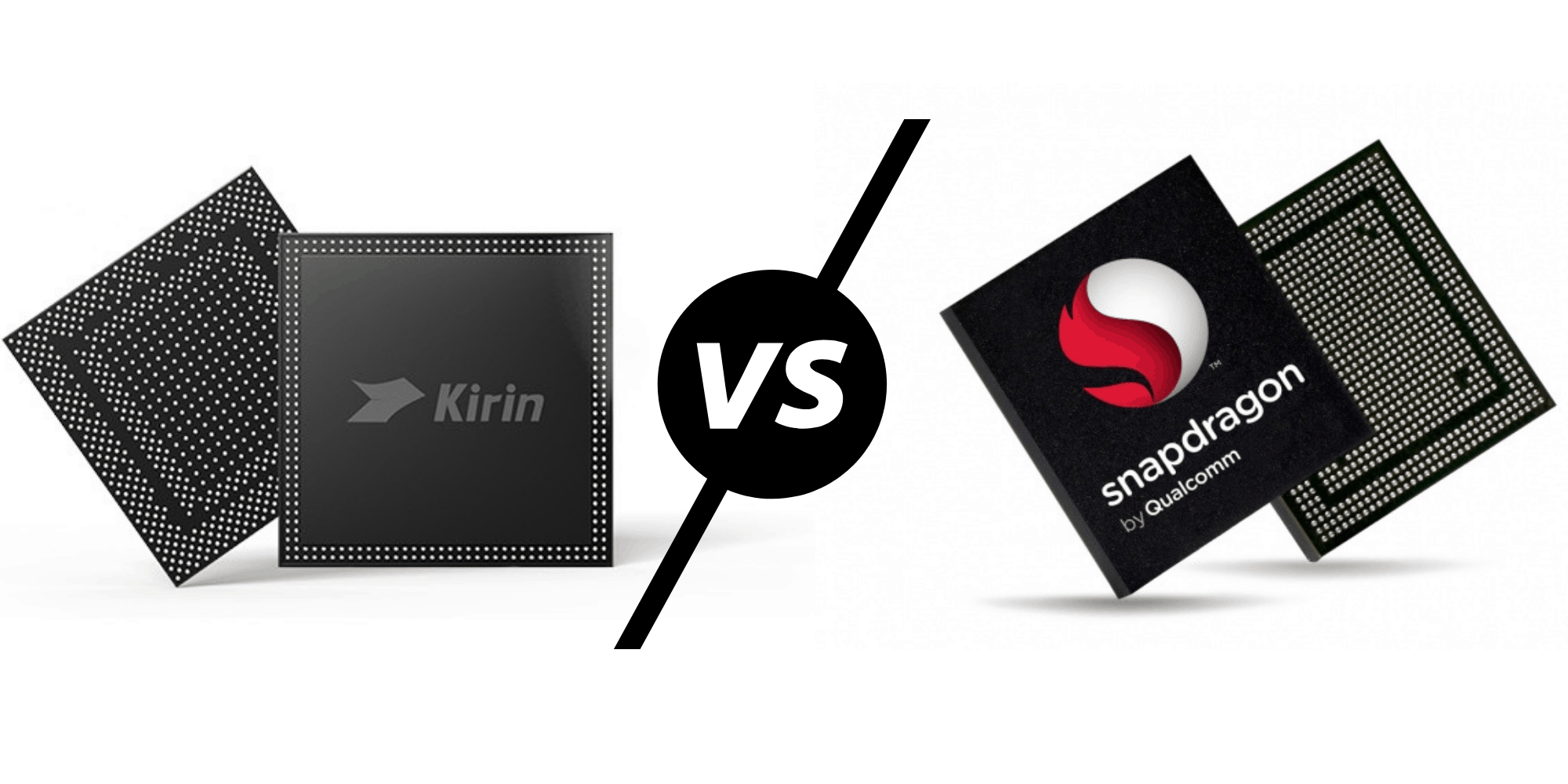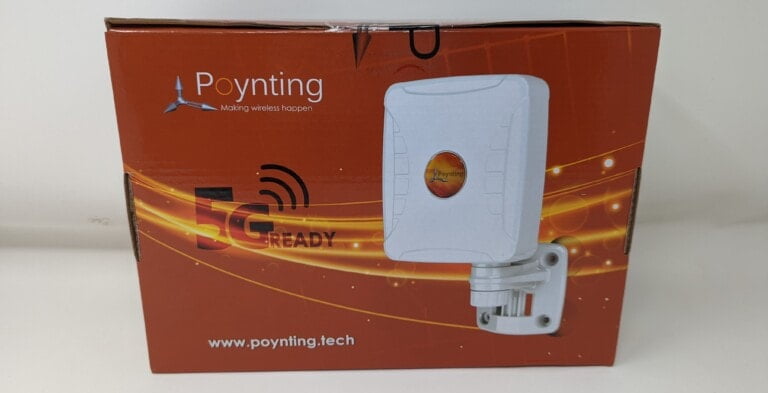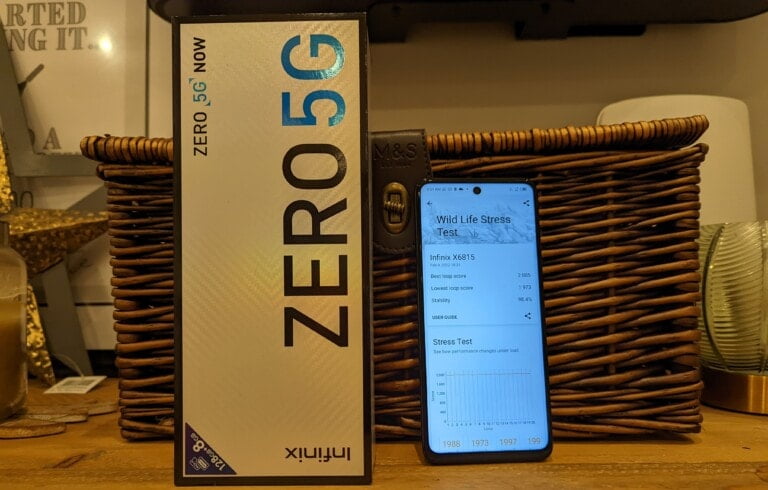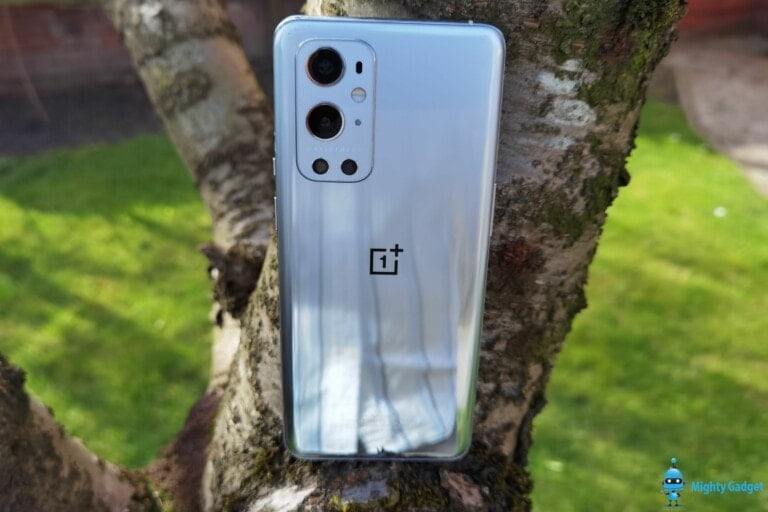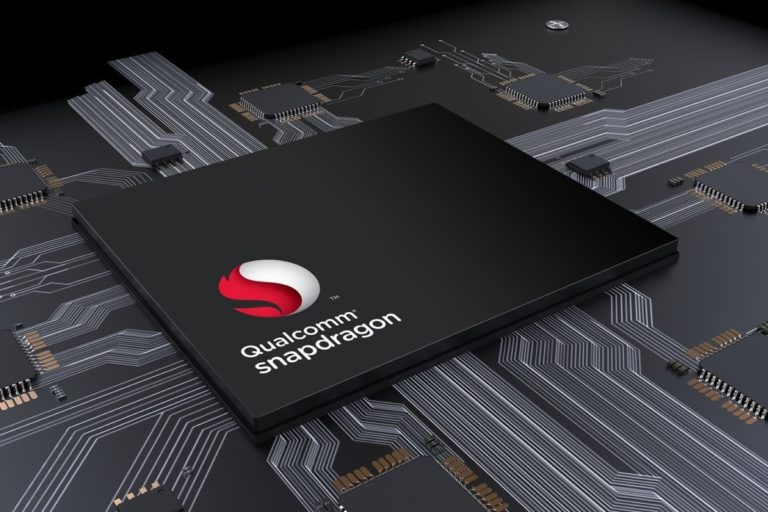Any links to online stores should be assumed to be affiliates. The company or PR agency provides all or most review samples. They have no control over my content, and I provide my honest opinion.
With the launch of the new HiSilicon Kirin 990 the ball is rolling for all the new phones of 2020. This gives a glimpse of what to expect for the year to come. Qualcomm will announce their new chipset in December, which will likely offer similar performance and features, this will then be followed by Samsung and their new Exynos chipset, probably in January/February for MWC.
So for now, the HiSilicon Kirin 990 is king of the hill, so how does it compare to the existing flagship chipsets on the market?
While the SD855+ and Exynos 9825 are technically newer chipsets, the SD855 is just a clock bump and the Exynos 9825 is only on one phone.
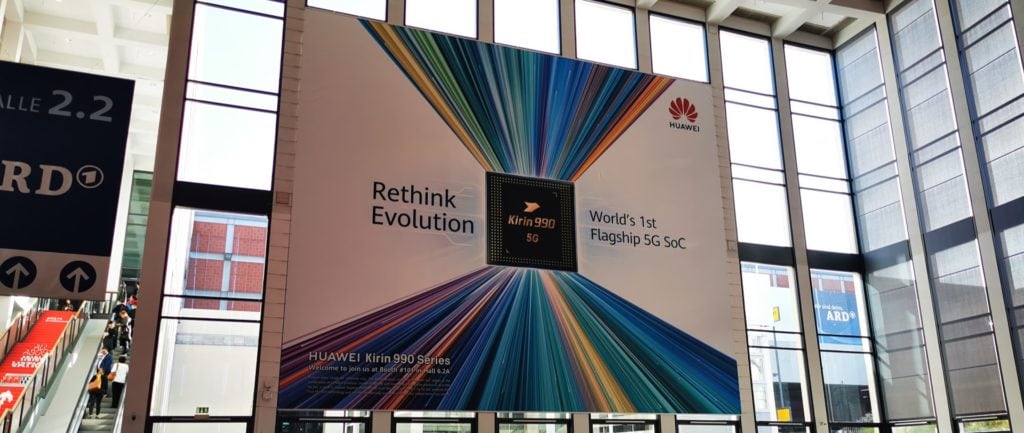
The below comparison is based on the Kirin 990 5G, it was quietly announced towards the end keynote that there is a none 5G Kirin 990.
Fabrication Process
The Kirin 990 uses the 7nm EUV (Extreme ultraviolet lithography) fabrication process, this is not the first chipset to use it, the recently launched Exynos 9825 is manufactured this way. When the 9825 launched it promised up to 20-30 percent higher transistor performance while consuming 30-50 percent less power.
The none 5G version still uses the normal 7nm fabrication process we saw on the Kirin 980, and the same as Qualcomm.
CPU Layout
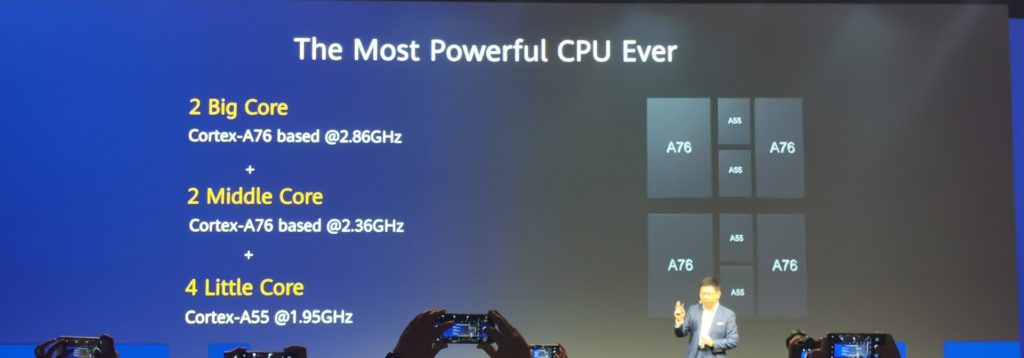
The Kirin 990 (5G) uses the same architecture as the Kirin 980, but with higher clocks.
The Kirin 990 (5G) now uses:
- 2x Cortex-A76 @ 2.86GHz
- 2x Cortex-A76 @ 2.36GHz
- 4x Cortex-A55 @ 1.95GHz
The Kirin 980 had
- 2x Cortex-A76 @ 2.6GHz
- 2x Cortex-A76 @ 1.92GHz
- 4x Cortex-A55 @ 1.8GHz
But then they announced the Kirin 990 without 5G which has lower clocks for the 2 middle cores and two lower cores.
While the ARM Coretex A77 has been announced, Qualcomm stated that even though A77 hits higher peak performance, the power efficiency of the A77 and A76 on 7nm is practically identical. As they have more experience with the A76 they have been able to achieve higher clocks than what would have been achievable on the A76.
| HiSilicon Kirin 990 5G | HiSilicon Kirin 990 | HiSilicon Kirin 980 | |
| Process | 7nm EUV | 7nm | 7nm |
| CPU Cores | Octa-Core, 64-bit | Octa-Core, 64-bit | Octa-Core, 64-bit |
| CPU | 2x Cortex-A76 @ 2.86GHz | 2x Cortex-A76 @ 2.86GHz | 2x Cortex-A76 @ 2.6GHz |
| 2x Cortex-A76 @ 2.36GHz | 2x Cortex-A76 @ 2.09GHz | 2x Cortex-A76 @ 1.92GHz | |
| 4x Cortex-A55 @ 1.95GHz | 4x Cortex-A55 @ 1.86GHz | 4x Cortex-A55 @ 1.8GHz |

GPU
The GPU remains the same technology, the Mali-G76 but this has now been upgraded to 16-cores compared to 10-cores of the previous generation.
The GPU performance sounds a little disappointing if anything, while they did not announce any hard numbers they claim only a 6% improvement over the Qualcomm Snapdragon 855. Obviously we will have to wait and see how the SD865 improves on the graphics department.
| HiSilicon Kirin 990 5G | HiSilicon Kirin 990 | HiSilicon Kirin 980 | |
| GPU | Mali-G76 MP16 | Mali-G76 MP16 | Mali-G76 MP10 |
5G Capabilities
The Kirin 980 had no native 5G capabilities, this was added via the Balong 5000 modem, similar to how the Snapdragon 855 also requires a X50 modem.
The Kirin 990 is the first native 5G chipset with the modem built into the chip. This is quite important because if you look at the Mate 20X vs the Mate 20X 5G, they had to drop the battery size ad change the speaker layout just to fit in a 5G modem.
There will also be a none 5G version (which he sneakily announced towards the end).
Imaging and Video

A 5th generation ISP with claims of professional DSLR level image noise reduction.
AI

With the 5G integration, Huawei are now claiming the chipset will do on-device AI processing, but then real-time cloud AI processing.
Huawei claims this will allow them to achieve 3 times the Ai performance compared to the Exynos 9820.
They have adopted a big little approach with the NPU to provide power savings. So for the 5G model, there are 2 big NPU’s and 1 smaller one which will be used for less
During the keynote, Huawei showed off some impressive AI features for photo editing which included people were playing musical instruments, and the smartphone camera could detect both the people from the background, and the people from each other. This allowed the software to change the background, from an indoor scene to an outdoor scene and such. What this also enabled was that individuals could be deleted, moved, or resized.
Some early benchmarks have come out for the AI performance via Ai-benchmark.com and this shows that the Kirin 990 scoring double what the Snapdragon 855 Plus is capable of and a three-fold improvement over the previous generation the Kirin 980. If this level of performance cross over to

Charging, Wi-Fi and more
The SD855 was the first to support Wi-Fi 6 but is only being used in the Samsung S10. The Kirin 990 should support this natively offering speeds up to.
The chipset will support both UFS 2.1 and 3.0, with the storage used being device-dependent. I would expect all Huawei flagship devices will now use UFS 3.0.
Benchmarks
An early benchmark has been leaked which appears to be for a phone using the none 5G variant as it lists the base frequency of 1.86Ghz.
The results are not overly impressive, with the chipset scoring a little above what the Snapdragon 855 Plus can achieve.
However it is worth noting that the none 5G model is perhaps more closely related to the Kirin 980 & Snapdragon 855 than it is a next gen chipset. It uses the same fabrication process as the previous generation and clocks the two sets of A76 cores higher. Earlier leaks indicated a Kirin 985 chipset that was due to launch, and I would regard this as a more accurate representation of this chipset.
Kirin 990 (not 5G)
- Single Core – 3842
- Multi-core – 11644
Snapdragon 855 Plus
- Single Core – 3623
- Multi-core – 11365
Challenges
How good this chipset performs is almost moot at the moment, we all know it will be fantastic, and it will be the best chipset until the Qualcomm Snapdragon 865 launches.
The biggest issue Huawei and HiSilicon face is the political landscape, with continued problems from the US, which at the moment means the new Mate 30 can’t launch with Google Apps.
How well this chipset performs matters less than how Huawei can either resolve or work around this issue.
Huawei appears to be ploughing forward like there are no issues, the Mate 30 is scheduled for launch on September the 19th, it could be they have an adequate solution for the problems faced, who knows.
Kirin 990 vs Kirn 980 vs Snapdragon 855 vs Exynos 9820 Specification Comparison
| HiSilicon Kirin 990 5G | HiSilicon Kirin 990 | HiSilicon Kirin 980 | Snapdragon 855 | Exynos 9820 | |
|---|---|---|---|---|---|
| Process | 7nm EUV | 7nm | 7nm | 7nm (N7) | 8 nm LPP (Low Power Plus) FinFET |
| CPU Cores | Octa-Core, 64-bit | Octa-Core, 64-bit | Octa-Core, 64-bit | Octa-Core, 64-bit | Octa-Core, 64-bit |
| CPU | 2x Cortex-A76 @ 2.86GHz 2x Cortex-A76 @ 2.36GHz 4x Cortex-A55 @ 1.95GHz (4MB shared L3 cache) | 2x Cortex-A76 @ 2.86GHz 2x Cortex-A76 @ 2.09GHz 4x Cortex-A55 @ 1.86GHz (4MB shared L3 cache) | 2x Cortex-A76 @ 2.6GHz 2x Cortex-A76 @ 1.92GHz 4x Cortex-A55 @ 1.8GHz (4MB shared L3 cache) | 1x Kryo 485 Gold (A76) @ 2.84GHz 1x512KB 3x Kryo 485 Gold (A76) @ 2.42GHz 3x256KB 4x Kryo 485 Silver (A55) @ 1.80GHz 4x128KB | 2x Custom CPU 2x Cortex-A75 4x Cortex-A55 |
| GPU | Mali-G76 MP16 | Mali-G76 MP16 | Mali-G76 MP10 | Adreno 640 @ 585MHz | ARM Mali G76 MP12 |
| NPU | 2+1 NPU with real time cloud AI | 1+1 NPU | Dual NPU | Yes (Hexagon 690 DSP) | Yes |
| RAM | LPDDR4X @ 2133MHz | LPDDR4X @ 2133MHz | LPDDR4X @ 2133MHz | 4x 16-bit CH @ 2133 MHz LPDDR4x 34.1GB/s | LPDDR4x |
| ISP | ISP 5.0 | ISP 5.0 | Dual ISP | Dual 14-bit Spectra 380 ISP 1x 48MP or 2x 22 MP | Dual ISP |
| Video Playback & Codecs | 4K @ 30fps - capture 4K @ 60fps playback | 4K @ 30fps - capture 4K @ 60fps playback | 4K @ 30fps - capture 4K @ 60fps playback | 2160p60 10-bit H.265 HDR10, HDR10+, HLG 720p480 | 2160p60 HEVC & H.264 Decode 2160p30 Encode HDR10 |
| Modem | 5G 2.3Gbps | 5G 2.3Gbps | LTE Cat 21 1.4Gbps down / 200Mbps up | Snapdragon X24 LTE (Category 20) DL = 2000Mbps 7x20MHz CA, 256-QAM, 4x4 UL = 316Mbps 3x20MHz CA, 256-QAM | LTE-A Cat.20 8CA (2Gbps download) Cat.20 3CA (316Mbps upload) |
| Wi-Fi | TBC | TBC | Hi1103 WiFi chip supports 1732Mbps with Wi-Fi and, Multi-gigabit Wi-Fi ac/b/g/n with MU-MIMO | Support for WiFi 6 standard (802.11ax) as well as the new 60GHz “Wi-Gig” 802.11ay, enabled by an external WiFi combo chipset. | Wi-Fi 802.11 a/b/g/n/ac |
| Charging | TBC | TBC | SuperCharge 4.5V / 5A low-voltage fast charging | Quick Charge 4+ (USB PD Compatible) | Samsung Adaptive Fast Charge, Fast Wireless Charging (Qi & PMA) |
I am James, a UK-based tech enthusiast and the Editor and Owner of Mighty Gadget, which I’ve proudly run since 2007. Passionate about all things technology, my expertise spans from computers and networking to mobile, wearables, and smart home devices.
As a fitness fanatic who loves running and cycling, I also have a keen interest in fitness-related technology, and I take every opportunity to cover this niche on my blog. My diverse interests allow me to bring a unique perspective to tech blogging, merging lifestyle, fitness, and the latest tech trends.
In my academic pursuits, I earned a BSc in Information Systems Design from UCLAN, before advancing my learning with a Master’s Degree in Computing. This advanced study also included Cisco CCNA accreditation, further demonstrating my commitment to understanding and staying ahead of the technology curve.
I’m proud to share that Vuelio has consistently ranked Mighty Gadget as one of the top technology blogs in the UK. With my dedication to technology and drive to share my insights, I aim to continue providing my readers with engaging and informative content.

